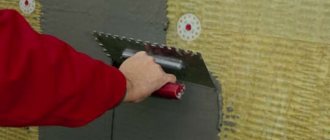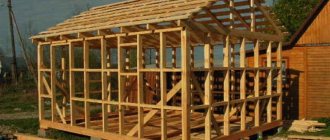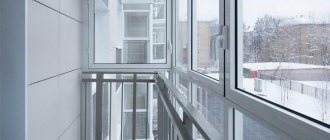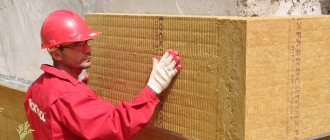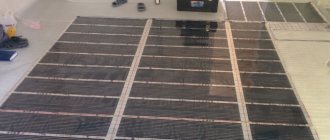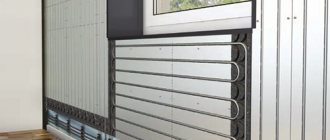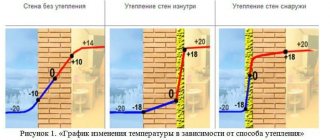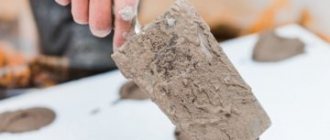One of the most important concepts in construction is dew point. At the stage of wall insulation, this allows you to correctly select the type and thickness of the heat-insulating material and create an optimal microclimate inside the building. There are several ways to determine the dew point. However, you also need to know what to do with the results obtained.
A short excursion into the physics of the phenomenon
The dew point is the temperature of the air at which excess moisture contained in it falls out in the form of condensation. Why is there too much of it? The fact is that warm air holds a large amount of water vapor, cold air holds much less. It is this temperature difference that forms condensation . An example of the phenomenon are drops of water on cold water pipes or windows, or fog.
What else you need to know about dew point:
- The higher the humidity, the closer it is to the air temperature, and vice versa.
- Its value cannot be higher than the air temperature.
- Condensation always appears on cold surfaces . This is explained by the fact that the warm air next to them cools and its humidity decreases.
The unit of measurement for the condensation point is degrees Celsius.
What is dew point?
This is a parameter numerically equal to the temperature at which water vapor begins to condense from cooled air, turning into dew. Its value can vary according to the thickness of the wall with temperature fluctuations inside and outside the building. If the temperature inside is maintained at the same level, and it starts to get colder outside, the dew point will begin to move closer to the inside wall.
The temperature at which steam begins to condense is affected by air temperature and humidity. So, at an air temperature of + 20 °C and a humidity of 50%, dew will fall on a surface cooled to +12.9 °C. To check this, it is enough to bring into the room an object cooled below +12.9C. Condensation will definitely appear on it. If, on the contrary, you open the refrigerator, warm air will begin to flow into it, from which dew will fall. Outwardly, it will look like fog coming out of a refrigerator.
There is also a place in the wall of the house where steam will condense if it is very cold outside. If the wall thickness is insufficient and its surface is cooled to a certain level, dew will begin to appear inside the room. As a result, the wall will constantly get wet and will soon become covered with mold.
That is why, when insulating, it is imperative to calculate the dew point, taking into account the highest and lowest values of humidity and temperature both inside and outside. This will allow you to find out how it will move in space with changes in temperature and humidity. Based on the obtained values, it will be possible to calculate the minimum wall thickness that will provide comfortable conditions inside the house.
Dew point in the wall of a house - why it is important to know it
Most of the year there is a significant difference between the temperature and humidity conditions outside and indoors. That is why areas of condensation often appear in the thickness of walls with insulation. When weather conditions change, they move closer to the outer or inner surface of the wall . That is, to a colder or warmer area.
Example: air temperature is stable at 25°C and humidity at 45%. In this case, condensation forms in an area with a temperature of 12.2°C. When humidity increases to 65%, the dew point shifts to a warmer area, where 18°C.
Why is it so important to know the location of the condensation point? Because it determines which layer of the wall “pie” is exposed to the destructive effects of moisture. The worst option is when the insulation gets wet. Under such conditions, most thermal insulation materials lose their properties. They become deformed, allow cold air to pass through , rot, and lose their elasticity. Mineral wool is especially susceptible to these processes.
Useful: Frame garage: step-by-step construction instructions
Role in the construction process
If the dew point turns out to be too high, then building materials such as cement, wood, metal and others will not produce the desired effect in the building and, even worse, will not last long. And if condensation forms on the surface of polymer materials during laying, this can cause the following defects:
- surface swelling;
- detachment;
- shagreen.
It is unlikely that it will be possible to visually calculate the dew point in the wall, since this will require a table of the corresponding indicators and a non-contact thermometer (we will talk about this procedure in the section “Determining the dew point and making calculations”).
Options for location of problem areas
The dew point tends to shift, but most often there are three zones of its location:
- Closer to the outer surface of the wall. This option occurs if the wall is not insulated . The appearance of a problem area is also possible if the external insulation is of insufficient thickness.
- Closer to the inner surface of the wall. In the absence of insulation, condensation easily forms in this place during cold weather. Internal insulation shifts the area of condensation formation to the area between the wall surface and the insulation . With external insulation, this phenomenon rarely occurs if all calculations were performed correctly.
- In the thickness of the insulation. For external thermal insulation this is the best option. With internal insulation, there is a high risk of mold appearing in the room and, as a result, microclimate disturbance .
Note! The formation of condensation in the wall is affected not only by the temperature and humidity conditions from the street and the room. Determining factors are also the thickness of the structure and the thermal conductivity of the materials used.
We determine the dew point and make calculations
We all want to live comfortably, but this is unlikely to be possible in conditions of high humidity. Condensation is harmful not only to the home (particularly to the walls), but also to human health (the risk of asthma increases). Moreover, if the humidity is high, then the walls and ceiling can become covered with mold, which is so harmful to the body and so difficult to remove. Often you even have to change all the finishing coatings to get rid of harmful microorganisms.
And in order to avoid all these troubles, we recommend calculating the dew point in the wall and thereby finding out whether it is advisable in your case to begin repair work, carry out insulation, or even start building a new house. It is worth remembering that the concept of dew point is individual for each specific building, therefore, it has to be calculated differently each time. But before proceeding directly to the calculations, it is necessary to take into account the following factors:
- climatic features of your region;
- presence and frequency of powerful wind;
- wall thickness;
- building material used in construction.
Humidity, although within acceptable limits, is contained in almost every material. You must ensure that it does not rise and condensation does not appear. And even if you call a specialist in case of increased humidity levels, he will most likely say that you have incorrect thermal insulation, the thickness of the building materials is not appropriate, or an error was made during installation. This is partly true, because it is competently carried out repairs that largely influence the location of the dew point and the formation of condensation on the surface of the walls.
Table for calculating dew point
Note! For intermediate numbers that are not indicated in the table, it is necessary to determine the average value.
Dew point calculation
The parameter value is calculated in several ways. This could be an online calculator, a pivot table, a special device, or a mathematical formula.
Using table data
A special table for calculating the dew point contains its approximate values. This is due to the fact that when breeding them, only air temperature and relative humidity were taken into account. The left column of the table shows the air temperature, the top line shows the relative air humidity as a percentage. At the intersection of columns and rows, the desired value is obtained.
There are several table options. However, most often the temperature range is -5°C..+30°C, and humidity – 30-95%. Using a table is convenient if you need to make calculations quickly. If possible, it is better to double-check the result in another way, for example, using a special online calculator.
Calculation using a mathematical formula
The mathematical formula for calculating the condensation temperature is complex and cumbersome. To perform calculations, two constant values are used, the actual value of air temperature and relative humidity . The latter must be taken in volume fractions.
Unlike working with a table, the range of the last two parameters is larger. The formula allows you to take into account temperatures from 0 to +60°C, humidity - from 1 to 100%. The error of the result does not exceed half a degree Celsius. However, it is convenient to use the formula only when you have free time for it.
Useful: Larry Hohn - building a frame house
Calculation in a calculator program
Special calculators allow you to calculate the dew point in the wall of a house online. You can find them on specialized websites. For the calculation you will need to enter a number of initial data. They vary from resource to resource, but the standard set includes information about the following parameters:
- wall material;
- the number of its layers and their thickness;
- temperature outside and inside the house;
- humidity indoors and outdoors.
Most calculators don't just calculate the required value. They also provide graphs of its possible movement and zones of moisture condensation.
Using instruments to perform calculations
Regardless of the method in which the calculations will be performed, source data . To obtain them you need to stock up on some devices. So, a regular thermometer is suitable for determining temperature, and a hygrometer is suitable for determining humidity. For convenience, they are combined in a device such as a digital thermohygrometer. All obtained values are displayed on a small screen. Some models of devices also determine the temperature of condensation. Some models of construction thermal imagers can also identify the problem area.
Determination of dew point position
Before determining the position of a point in the wall, several indicators are recognized:
- ambient and indoor temperature;
- humidity outside and inside the building;
- wall thickness.
In uninsulated walls
Uninsulated walls lose a lot of heat, the point is located directly in it. The material becomes damp and becomes moldy. Due to temperature changes outside and inside, the wall is subject to destruction.
In externally insulated walls
In this case, the point is insulated, and the wall is protected from weather conditions. The ceiling is always dry, and the heat in the room is retained.
In internally insulated walls
The wall outside begins to freeze and collapse. Condensation accumulates between the outside and the insulation because the point is in the middle of the layers. This leads to the proliferation of pathogenic flora.
How to move the dew point in a wall
If after all the calculations you are not satisfied with the location of the dew point, you should think about shifting it. To do this you can:
- increase the layer of insulation on the outside;
- use material with high vapor permeability;
- dismantle the layer of internal insulation, moving it outside;
- adjust the microclimate in the room - install forced ventilation, additionally heat the air.
The appropriate option is chosen based on the climatic conditions of the region of residence, the design features of the house, financial capabilities and the building materials used.
Ignoring such a phenomenon as moisture condensation in the wall “pie” can be very expensive. At a minimum, this is an unpleasant smell in the room, constant dampness . At the most, there are large colonies of mold fungi that spoil the interior decoration of the walls, destroy the insulation and harm the health of household members. Therefore, calculating the dew point is essential if you want to build safe and dry walls for your home.
We carry out the calculation
When determining the required value, several factors should be taken into account:
- temperature inside and outside the house;
- air humidity.
Temperature and relative humidity
The value depends on the location of the building. In most cases we will be talking about 20 – 22 °C. For those who live in areas where the five-day period is the coldest, that is -31°C and below, the indicated value will be 21–23°C.
The acceptable value is slightly different. For cold regions it will be 20 – 24 °C. For the middle zone, the temperature range will expand to 18 – 24 °C. When a calculation is performed, it is usually taken in the first case to be 20 °C, in the second - 22 °C.
The permissible relative humidity ranges from 35–60%. For calculations, you can take 50–55%.
Looking for a table value
To find the desired value, you should use a special table in which the condensation value is presented depending on temperature and humidity. To do this, having decided on temperature and humidity, you can find the desired value at the place where they intersect. So, if the humidity is taken to be 55% and the temperature is 21°C, the dew point is 11.6°C. This means that where the wall cools to 11.6 °C, condensation will form.
Exact value
To get a more accurate figure, you can determine the condensation value using real data. To do this, you should acquire the following tools:
- an ordinary thermometer;
- hygrometer;
- non-contact thermometer. If you don't have one, you can use the usual one.
You should start searching for the value by measuring the air temperature at a distance of 60 cm from the floor surface. A larger distance from the floor surface will result in incorrect data. In this case, measurements are often carried out by placing the thermometer on the table.
After this, the humidity in the room is measured using a hygrometer. This should be done in the same place where the temperature was measured. The search for the condensation value is carried out in the same sequence as described above.
Dew point determination
Dew point values in °C for a number of situations are determined using a sling psychrometer and special tables. First, determine the air temperature, then the humidity, the temperature of the substrate, and using the Dew Point table, determine the temperature at which it is not recommended to apply coatings to the surface.
If you cannot find your exact reading on the sling psychrometer, then find one reading one notch higher on both relative humidity and temperature scales, and another reading correspondingly one notch lower, and interpolate the required value between them.
The ISO 8502-4 standard is used to determine the relative humidity and dew point of a steel surface prepared for painting.
Temperature table
The dew point values in degrees Celsius under different conditions are shown in the table.
| Relative humidity, % | Dry bulb temperature, °C | ||||||||||
| 2,5 | 5 | 7,5 | 10 | 12,5 | 15 | 17,5 | 20 | 22,5 | 25 | ||
| 20 | −20 | −18 | −16 | −14 | −12 | −9,8 | −7,7 | −5,6 | −3,6 | −1,5 | −0,5 |
| 25 | −18 | −15 | −13 | −11 | −9,1 | −6,9 | −4,8 | −2,7 | −0,6 | 1,5 | 3,6 |
| 30 | −15 | −13 | −11 | −8,9 | −6,7 | −4,5 | −2,4 | −0,2 | 1,9 | 4,1 | 6,2 |
| 35 | −14 | −11 | −9,1 | −6,9 | −4,7 | −2,5 | −0,3 | 1,9 | 4,1 | 6,3 | 8,5 |
| 40 | −12 | −9,7 | −7,4 | −5,2 | −2,9 | −0,7 | 1,5 | 3,8 | 6,0 | 8,2 | 10,5 |
| 45 | −10 | −8,2 | −5,9 | −3,6 | −1,3 | 0,9 | 3,2 | 5,5 | 7,7 | 10,0 | 12,3 |
| 50 | −9,1 | −6,8 | −4,5 | −2,2 | 0,1 | 2,4 | 4,7 | 7,0 | 9,3 | 11,6 | 13,9 |
| 55 | −7,8 | −5,6 | −3,3 | −0,9 | 1,4 | 3,7 | 6,1 | 8,4 | 10,7 | 13,0 | 15,3 |
| 60 | −6,8 | −4,4 | −2,1 | 0,3 | 2,6 | 5,0 | 7,3 | 9,7 | 12,0 | 14,4 | 16,7 |
| 65 | −5,8 | −3,4 | −1,0 | 1,4 | 3,7 | 6,1 | 8,5 | 10,9 | 13,2 | 15,6 | 18,0 |
| 70 | −4,8 | −2,4 | 0,0 | 2,4 | 4,8 | 7,2 | 9,6 | 12,0 | 14,4 | 16,8 | 19,1 |
| 75 | −3,9 | −1,5 | 1,0 | 3,4 | 5,8 | 8,2 | 10,6 | 13,0 | 15,4 | 17,8 | 20,3 |
| 80 | −3,0 | −0,6 | 1,9 | 4,3 | 6,7 | 9,2 | 11,6 | 14,0 | 16,4 | 18,9 | 21,3 |
| 85 | −2,2 | 0,2 | 2,7 | 5,1 | 7,6 | 10,1 | 12,5 | 15,0 | 17,4 | 19,9 | 22,3 |
| 90 | −1,4 | 1,0 | 3,5 | 6,0 | 8,4 | 10,9 | 13,4 | 15,8 | 18,3 | 20,8 | 23,2 |
| 95 | −0,7 | 1,8 | 4,3 | 6,8 | 9,2 | 11,7 | 14,2 | 16,7 | 19,2 | 21,7 | 24,1 |
| 100 | 0,0 | 2,5 | 5,0 | 7,5 | 10,0 | 12,5 | 15,0 | 17,5 | 20,0 | 22,5 | 25,0 |
Comfort range
A person feels uncomfortable at high dew point values. In continental climates, conditions with a dew point between 15 and 20 °C cause some discomfort, and air with a dew point above 21 °C is perceived as stuffy. A lower dew point, less than 10 °C, correlates with lower ambient temperatures and the body requires less cooling [ source unspecified 2473 days
].
| Dew point, °C | Human perception | Relative humidity (at 32 °C), % |
| more than 26 | extremely high perception, deadly for asthma patients | 65 and above |
| 24—26 | extremely uncomfortable condition | 62 |
| 21—23 | very humid and uncomfortable | 52—60 |
| 18—20 | unpleasant for most people | 44—52 |
| 16—17 | comfortable for most, but feels at the upper limit of humidity | 37—46 |
| 13—15 | comfortable | 38—41 |
| 10—12 | very comfortable | 31—37 |
| less than 10 | a little dry for some | 30 |
Details
Where should TR be?
The best place for the dew point to appear in the wall will be insulation placed outside the wall. The thickness of the insulating layer on the wall should be such that during the cool season, condensation does not move into the wall itself, or if it begins to move, but not for a long time. We will consider further the destructive consequences of the presence of TP in the body of a load-bearing wall. Walls based on porous materials (gas blocks and foam blocks), shell rock and other materials require a larger layer of insulation, as they perfectly absorb and retain moisture. It turns out that even a short-term (several days) stay in the porous wall of the TR can have a destructive effect on the internal integrity. And therefore, warm materials for laying walls can be effective only in certain regions, with far from the frostiest winters.
If, according to calculations, the dew point will move into the wall of the house from time to time or there is a high probability of shifting, then this fact is important to take into account when choosing a material for wall installation. For such a case, wall materials with a high degree of density are perfect, and those that can withstand many cycles of freezing and thawing, without damage, with a huge frost resistance coefficient. Frost-resistant materials include brick and expanded clay concrete. The table shows all the frost resistance indicators of the most popular wall materials.
How to calculate the dew point in a frame house with insulation
It is unrealistic to calculate one specific place on the wall where condensation will manifest itself. Since finding the dew point will depend on certain parameters and this indicator is changeable. You can only calculate a certain distance in the wall thickness where liquid will appear with different temperature changes outside the house. For example, if the temperature in the room is stable, but it has become sharply cold outside, then the dew point will begin to shift along the thickness of the walls closer to the room. Using the formula, you can obtain the most accurate calculations of dew for both a homogeneous and multi-layer wall. It is extremely simple to calculate the location of the dew point in all multi-layer walls, and in order to find out the dew point in a frame house, you need the following indicators:
Room air temperature.- Temperature outside.
- Separate thickness of all layers of walls.
- Thermal resistance coefficient of materials from which house walls are built.
- TP at relative air humidity in the region (table below).
To determine the part of the planned wall in which there will be a dew point and condensation, it is important to know about such indicators.
- Temperature TR in the region, with the humidity and air temperature in the room you need. This indicator can be viewed in the table above.
- The air temperature that appears at the boundary of a pair of wall layers, at the parameters of interest. Let's call this TS (point between layers).
If the difference in the above indicators becomes positive, then TR will be in the insulation, if the indicator is negative, and TR will begin to accumulate liquid in the house or wall. In other words, if the temperature at the junction of the insulation and the walls is higher and has a + sign than the TP temperature according to the table, then condensation will appear in the insulation. Let's look at an example. The TP temperature in a region with a humidity of 60% and a room temperature of +21 degrees, according to the table will be +12.9 degrees. The air temperature at the boundary of the insulating layer and the wall is +15 degrees. The difference between the indicators is +2.1 degrees. If the difference in the indicators noted above is positive, as in this case, then the dew point will be in the insulation; if the indicator is negative, then the TP will begin to accumulate liquid in the house wall.
In our case, the temperature of liquid release from steam will be earlier than the moisture-saturated air reaches the main wall. Condensation will fall in the insulation, and not in the load-bearing wall part or inside it. The question arises that if we select the TP temperature at a given humidity from the table, then calculate the temperature between the wall layers in this way.
Calculating the air temperature at the boundary of a pair of wall layers is very simple, using the following formula:
TS=(T2-T1)*(C1*0.01/k)/(C2*0.01/k)
T2 – indoor air temperature.
T1 – air temperature from the street side.
C1 – thickness of wall material.
K is the heat coefficient of the wall material.
For example, let's choose a region where the dew point is +12.9 degrees with a humidity of 60%, the room temperature is +21 degrees and the outside temperature is -12 degrees. Next, you need to calculate for such conditions what the temperature will be between an ordinary wall of 1.5 bricks with a thickness of 0.38 meters and the external appearance of foam insulation, a thickness of 0.1 meters. To remove the TP temperature from the table. To do this, use the formula. You will get the following:
T2 is =21 degrees (air temperature in the room).
T1 is - 13 degrees (air temperature outside).
C1 is 0.38 meters (thickness of the wall material).
K1 – 0.6 (thermal resistance coefficient of bricks).
C2 – 0.1 meter (thickness of the insulation layer made of polystyrene foam).
K2 is 0.04 (thermal resistance coefficient of foam sheets).
Calculation of the temperature between a brick wall and foam insulation, in the climate conditions we have chosen 9.52.
According to calculations, the air temperature between 0.1 meter foam insulation and 0.38 meter brick wall at an outside air temperature of -13 degrees and a house temperature of +21 is 9.52. So, if you make calculations, the dew point due to which the insulation gets wet will be -3.38. As you can see, the result will be a negative indicator, i.e. The air will reach a state of condensation in the brick wall and moisture will begin to accumulate in it. The given calculation of TP will be the most accurate, with an error of up to ½ degree, in contrast to certain online calculators and other devices that are not able to take into account different material structures.
Calculation of dew point on a calculator/device
There are many online programs (calculators) on the Internet that can be used to calculate the approximate placement of the TP in the wall. The program will calculate TR based on many indicators that are important to enter manually. This is information about the materials from which you plan to build walls, the number of wall layers and their thickness, air temperature inside and outside, as well as air humidity. Calculators are easy to use, and along with digital calculations, you will be able to see charts and graphs of the movement of the TP depending on changes in air temperature. But the calculation results for most calculators differ and how accurate the calculations are is unknown.
TP can be determined even in real time, using a special device. This is an electrical device with a monitor that displays information about indoor humidity, air temperature and TP. These devices are relevant for changing the dew point in an already completed and erected building structure. This device will not help when designing wall thickness and building.
Damage to dew point for house walls
We considered that the TR can be placed in 3 different wall sections:
- In the external form of wall insulation.
- In the walls, closer to the outside.
- In the wall surface, closer to the inside.
In each of the places that are listed, TR will manifest itself differently. If in one place it is harmless, then inside the house/wall it will have devastating consequences on the integrity of the wall. Below we will consider the behavior of TR in each of the described places.
Dew point in external insulation
This is the most harmless finding of TP for the home, and in this case:
- When TP gets in, condensation forms in the insulation itself.
- The layer of insulation material is not hygroscopic, and therefore moisture will not linger in the wall structure and evaporate when the air temperature changes.
- Due to the vapor barrier properties of the insulating material, the moisture that appears during the evaporation of condensation will go outside and will not interact with the house wall.
- House walls are dry throughout the year, both outside and inside.
- The walls will maintain strength and integrity for many decades.
Let's consider another option.


